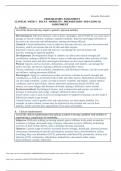Amanda Alexandre
PREPARATORY ASSIGNMENT
CLINICAL WEEK 5 - FOCUS - MOBILITY: PREPARATORY AND CLINICAL
ASSIGNMENT
A. Factors
List all the factors that may impact a patient’s physical mobility.
Microbiological: Infectious diseases, such as polio, meningitis, and COVID-19, can cause nerve
damage or muscle weakness, leading to impaired mobility. Bacterial and fungal infections of
the joints can cause pain and inflammation, making movement difficult
Chemical: Certain medications, such as sedatives and pain relievers, can cause drowsiness and
dizziness, which can increase the risk of falls and other injuries.
Exposure to toxins, such as lead and mercury, can damage the nervous system and
muscles, resulting in impaired mobility.
Developmental: Developmental delays in children can affect their muscle strength and
coordination, making it difficult for them to learn to walk and perform other activities of daily
living. Cerebral palsy and other neurological disorders can also cause impaired mobility.
Physical: Injuries, such as fractures, dislocations, and spinal cord injuries, can damage the
bones, muscles, and nerves, making it difficult or impossible to move.
Chronic conditions, such as arthritis, osteoporosis, and Parkinson's disease, can also cause pain
and stiffness, making movement difficult.
Physiological: Aging is a natural process that can lead to a decline in muscle strength and
coordination, as well as an increased risk of falls and other injuries. Malnutrition and obesity
can also impair mobility, as they can lead to muscle weakness and fatigue. Certain medical
conditions, such as heart failure, chronic obstructive pulmonary disease (COPD), and
anemia, can cause fatigue and shortness of breath, making it difficult to move around.
Psychosociocultural: Psychological factors, such as depression and anxiety, can lead to a
decrease in motivation and energy, making it difficult to move around.
Social factors, such as lack of access to transportation or supportive housing, can also make it
difficult for people to get around.
Cultural factors, such as gender roles and expectations, can also impact mobility. For
example, in some cultures, women may be expected to stay at home and care for their
families, which can limit their opportunities to be active and mobile.
B. Clinical manifestations:
List all the clinical manifestations that indicate a patient is having a problem with mobility or
experiencing a complication of immobility.
Subjective: Difficulty walking or moving around, pain or stiffness in the joints or muscles,
weakness or fatigue, decreased range of motion, reluctance to move, difficulty performing
activities of daily living (ADLs), such as bathing, dressing, and eating
Objective: Limited range of motion, decreased muscle strength, altered gait, abnormal posture,
contractures (shortening of muscles and tendons), pressure ulcers, skin breakdown, edema
(swelling), deep vein thrombosis (DVT), pulmonary embolism (PE), pneumonia, urinary tract
infection (UTI), constipation, dehydration, malnutrition, decreased cardiac output,
hypoventilation, anxiety, depression
This study source was downloaded by 100000890485048 from CourseHero.com on 09-15-2024 11:15:24 GMT -05:00
https://www.coursehero.com/file/230334156/Week5ClinicalPrepdocx/




